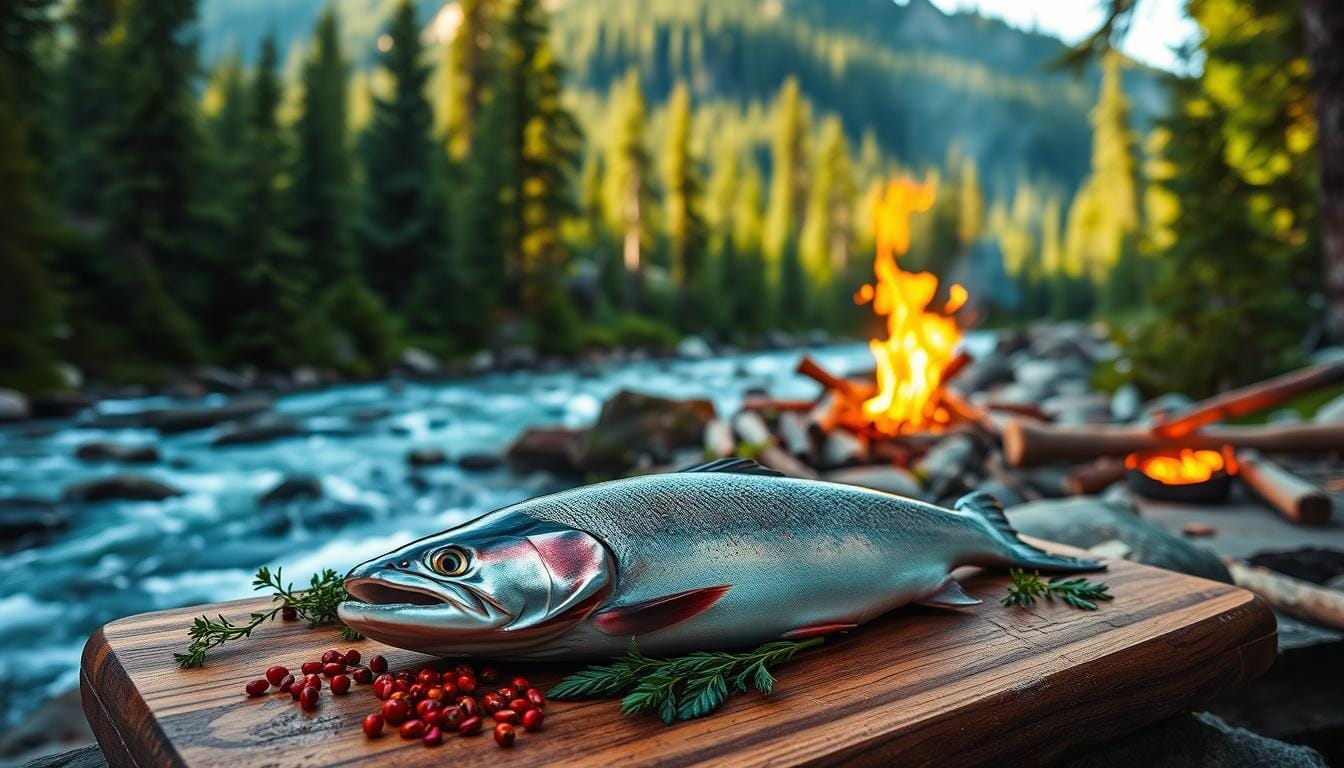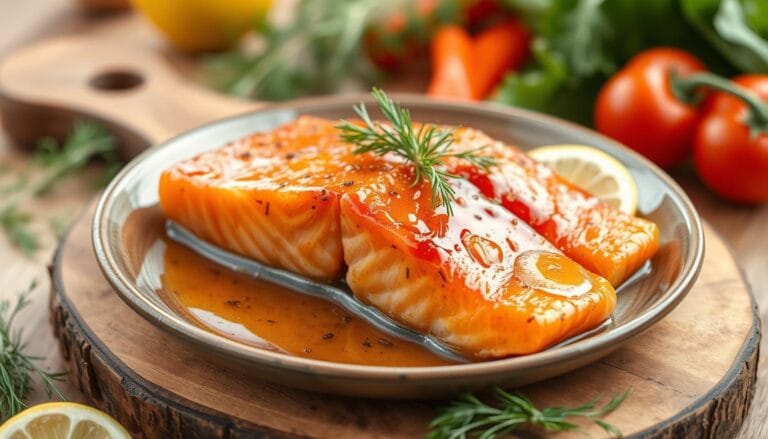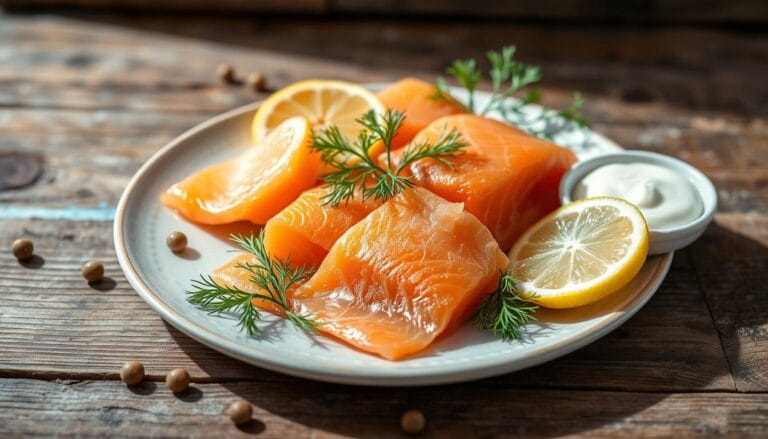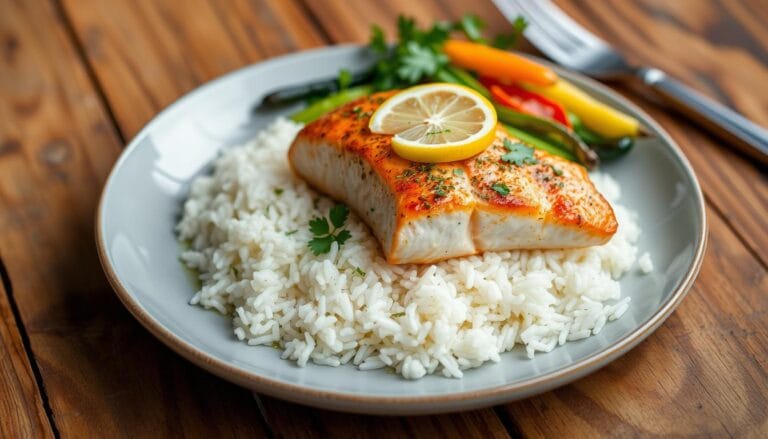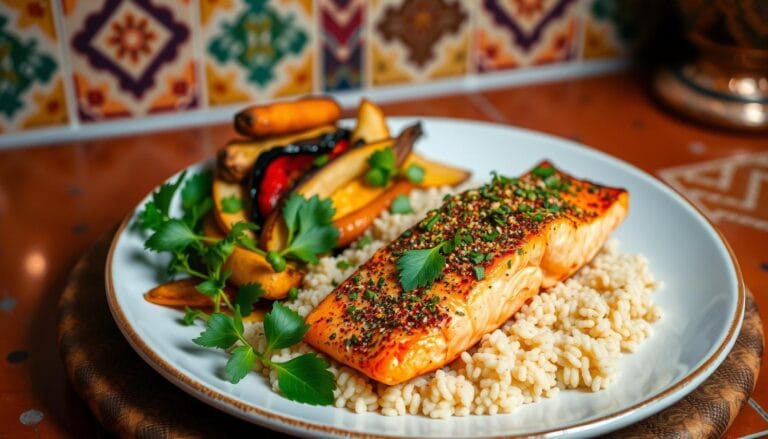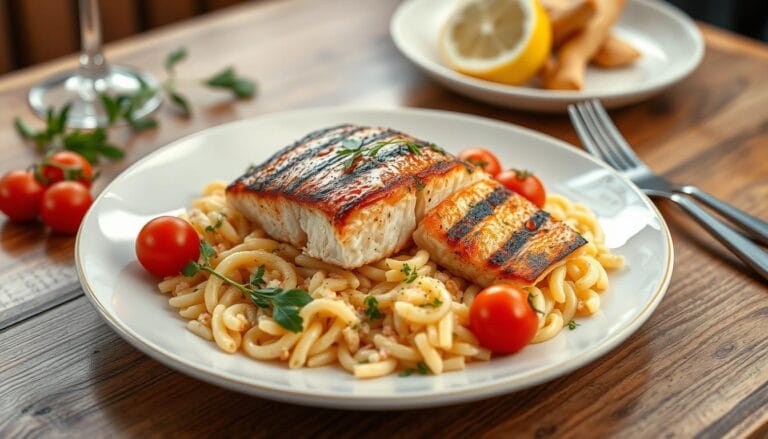Best Wilderness Salmon Recipe – Fresh & Delicious
As the sun sets behind the pines, the smell of sizzling salmon fills the air. It awakens your senses and takes you to a world of wild flavors. This is your chance to enjoy the beauty of nature and make a meal that feels like the wilderness.
We’re going to make the perfect wilderness salmon recipe. It’s a dish that will not only fill your belly but also warm your heart. Whether you love backpacking, camping, or just great food outdoors, this recipe will be your new favorite.
Table of Contents
Essential Ingredients for Your Outdoor Salmon Adventure
Starting a wilderness grilled salmon journey needs careful planning. You’ll need the right ingredients and tools. Let’s explore what makes your campfire cooking great.
Core Marinade Components
The key to a tasty grilled salmon marinade is a mix of flavorful liquids. Mix 1/3 cup of soy sauce, 1/3 cup of vegetable oil, 1 1/2 tablespoons of rice vinegar, and 1 teaspoon of sesame oil. This marinade will give your grilled salmon a unique savory-sweet taste.
Fresh Herbs and Seasonings
Add to the marinade with fresh herbs and seasonings. Chop 1/4 cup of green onions, grate 1 tablespoon of fresh ginger, and mince 1 teaspoon of garlic. These will add depth and complexity to your campfire cooking.
Equipment Checklist
- 3 (12 inch) untreated cedar planks
- Grill or campfire setup
- Cast iron skillet (optional)
With these ingredients and tools, you’re ready to make a delicious grilled salmon dish. It’s sure to impress your fellow adventurers.
Preparing Your Wilderness Salmon Recipe
Start your outdoor cooking journey with the right steps for your wild-caught salmon. First, remove the skin from your 1 lb fresh Alaskan salmon fillets. This makes a clean surface for your tasty marinade.
Then, soak your cedar planks in warm water for at least an hour. Longer is better to keep them from burning. This helps your salmon cook evenly over the open fire.
- Remove skin from 1 lb fresh Alaskan salmon fillets.
- Soak cedar planks in warm water for 1 hour or longer.
Next, mix up the marinade to flavor your salmon. In a shallow dish, whisk together soy sauce, oils, vinegar, and seasonings. Place the salmon fillets in the marinade, making sure they’re fully coated. Let it marinate for 15 minutes to 1 hour in the fridge for better flavor.
“Marinating is the key to unlocking the full potential of your wild-caught salmon. The right blend of ingredients can transform a simple fillet into a culinary masterpiece.”
With your salmon ready and your cedar planks soaked, you’re set for the next part of your outdoor cooking. Get ready for the amazing aroma and perfect texture of your wilderness salmon recipe.
The Perfect Marinade: Asian-Inspired Wilderness Blend
Creating the perfect marinade is key to enjoying the wilderness’s flavors. For your wilderness salmon recipe, try an Asian-inspired mix. It will make your salmon taste amazing and tender.
Soy-Ginger Base Preparation
Start by mixing soy sauce, vegetable oil, rice vinegar, and sesame oil in a bowl. Add chopped green onions, fresh ginger, and garlic. For more flavor, add a teaspoon of Dijon mustard. Whisk until smooth and flavorful.
Marination Timing Tips
- Marinate your outdoor recipes salmon for 15 minutes to 1 hour in the fridge.
- This ensures the fish soaks up all the tasty Asian flavors without losing its tenderness.
- Always throw away the marinade after use. It’s been in contact with raw salmon.
With this marinade, your wilderness salmon recipe will be a campfire hit. Enjoy the salty, sweet, and umami flavors in every bite!
Cast Iron Skillet vs Cedar Plank Methods
When cooking your fresh catch, you can choose between a cast iron skillet and a cedar plank. Both methods can make your salmon taste amazing.
The cedar plank method starts with heating your grill to medium. Place soaked cedar planks on the grill until they smoke. Then, put your salmon fillets on the planks and grill for 20 minutes. The cedar adds a smoky flavor to the salmon.
The cast iron skillet is great for open-fire cooking and campfire cooking. Heat the skillet over the campfire. Once hot, add your salmon fillets. Cook for about 20 minutes, adjusting the heat to get it just right.
| Cedar Plank Method | Cast Iron Skillet Method |
|---|---|
| Imparts a subtle smoky flavor | Excellent for open-fire cooking and campfire cooking |
| Requires preheating grill and soaking planks | Allows for easy temperature control over the campfire |
| Grills salmon for about 20 minutes | Cooks salmon for a similar time, adjusting heat as needed |
Both cedar plank and cast iron skillet are great for cast iron skillet cooking outdoors. Try both to see which one you like best for your wilderness cooking.
Step-by-Step Campfire Cooking Guide
Take your wilderness salmon recipe to the next level with campfire cooking. Whether grilling, skillet-searing, or using a cedar plank, the secret to great salmon is in the fire and temperature. Follow these steps for a delicious campfire cooking experience.
Fire Preparation
Start with a medium-hot campfire or grill. For cedar plank cooking, heat the planks until they start to smoke. This adds a smoky flavor to your salmon.
Temperature Control Techniques
- Keep an eye on the fire’s heat to ensure it stays medium-high.
- Adjust the grill or salmon position on the planks for even cooking.
- Close the grill lid to control temperature and cook evenly.
Cooking Time Guidelines
Cook your salmon for about 20 minutes, adjusting for thickness and fire heat. It will cook a bit more after removal, so aim for slightly underdone.
Rotate or gently move the salmon as it cooks. This ensures even cooking. Patience, attention to detail, and practice are key for tender, flavorful salmon.
By following these steps, you’ll master campfire cooking and create a tasty wilderness salmon recipe. Enjoy the rustic charm of open-fire cooking and let the wild flavors shine in every bite.
Wild-Caught Salmon Selection Tips
When planning your outdoor salmon adventure, it’s crucial to select the freshest, wild-caught salmon fillets. Look for firm, vibrant flesh that springs back when gently pressed. Avoid any salmon that appears dull, discolored, or soft to the touch.
If using frozen salmon, thaw it completely before marinating and cooking. Properly thawed salmon will have a smooth, even texture. This is unlike partially thawed fillets that can be uneven and challenging to work with. For the ultimate taste and quality, consider sustainable wild-caught salmon options. This supports conservation efforts and lets you enjoy the true essence of this sustainable seafood.
- Opt for fresh, wild-caught salmon fillets for maximum flavor and texture.
- Ensure frozen salmon is completely thawed before marinating and cooking.
- Choose sustainable wild-caught salmon to support conservation and enjoy the finest quality.
“The best salmon I’ve ever tasted came straight from the waters of Alaska. Wild-caught salmon is a true delicacy.”
Alaska’s fishing season is short, and availability fills up quickly. This is especially true for such a unique destination. So, early booking is strongly encouraged. Fall is a hidden gem for fishing trips in Alaska with fewer people, bugs, and the opportunity to catch delicious cold water fish. Summer is the peak season for trout fishing in Alaska. This is due to longer days and an abundance of fish, particularly Dolly Vardens, cutthroat, and steelhead.
Complementary Wilderness Side Dishes
Pairing your grilled salmon with quick, easy side dishes is a great idea. You can make these at your campsite. Foraging for ingredients in nature adds flavor and connects you with the outdoors.
Foraged Ingredients
Look for edible plants in your area, depending on the season. Some good finds include:
- Wild asparagus
- Fiddlehead ferns
- Ramps (wild leeks)
- Stinging nettles
- Dandelion greens
Just clean and sauté these plants with olive oil, salt, and pepper. This makes a tasty side dish that goes well with your salmon.
Quick Campsite Preparations
For a crowd-pleaser, toss green beans or asparagus with olive oil, salt, and pepper. Roast orange slices with your salmon for a sweet touch. Serve these sides over quinoa or rice for a complete meal.
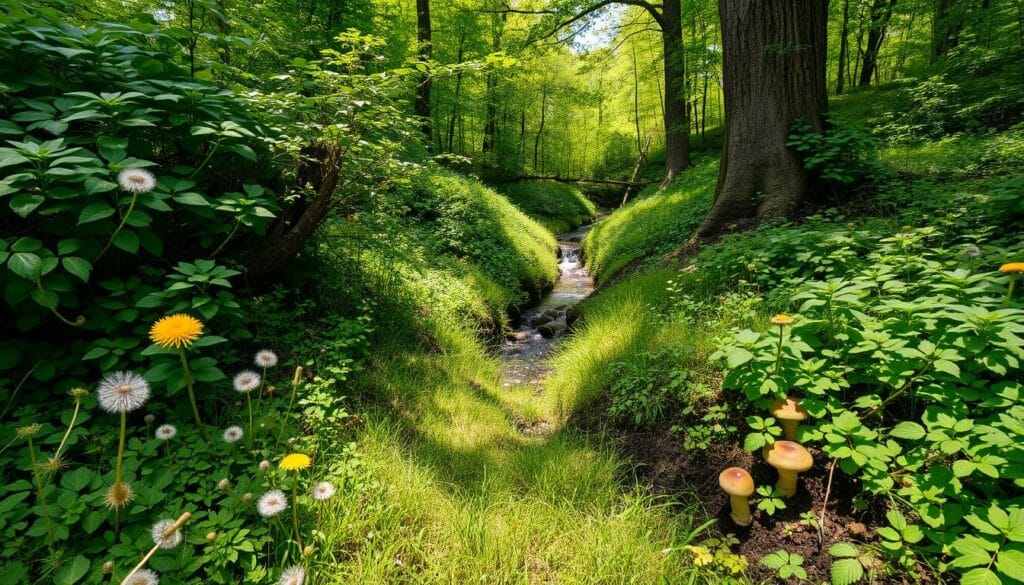
Adding foraged and simple side dishes makes your salmon meal better. You’ll enjoy the tastes of nature around you.
Sustainable Fishing and Conservation Practices
Enjoying the outdoors and tasting wild-caught salmon is great. But, we must think about how we catch it. Making smart choices helps protect these resources for the future.
The U.S. has some of the biggest and most sustainable fisheries. Places like the Woods Hole Laboratory help manage fish populations. They guide us in fishing responsibly.
Row 34 is a seafood restaurant group in New England. They work with NOAA to learn about the ocean. This helps them serve wild-caught salmon that’s good for the planet. They also teach their customers why sustainable seafood matters.
| Sustainable Fishing Practices | Conservation Efforts |
|---|---|
|
|
As we explore the wilderness for salmon, let’s remember the balance of nature. Choosing sustainable seafood and supporting conservation lets us enjoy nature’s gifts. This way, we ensure nature stays vibrant for future generations.
“Sustainable fisheries focus on maintaining fish populations, protecting the environment, and supporting local communities.”
Troubleshooting Common Outdoor Cooking Challenges
Cooking outdoors is exciting and rewarding. But, it comes with its own set of challenges. Whether you’re making a wilderness salmon dish or trying out campfire cooking, knowing how to handle weather and keep the temperature right is key.
Weather Considerations
Weather can change fast, and outdoor cooks need to be ready. In windy weather, setting up windbreaks is important. You can use big rocks, tarps, or even your car to block the wind and keep the heat steady.
When it rains or is humid, keeping the cooking area dry is hard. In these cases, using a portable cooking shelter or canopy can help keep your food and cooking area dry.
Temperature Management
Getting your salmon to the right temperature is crucial for safety and taste. Use a good meat thermometer to check the temperature. Adjust your cooking time based on the fire’s heat and the air temperature.
If the fire is too hot, move your cooking to a cooler spot on the grill. Or, adjust the airflow to lower the heat. If the fire is too cool, add more fuel or change the log placement to improve airflow and heat.
By tackling these common outdoor cooking issues, you’ll have a great time making a tasty wilderness salmon dish.
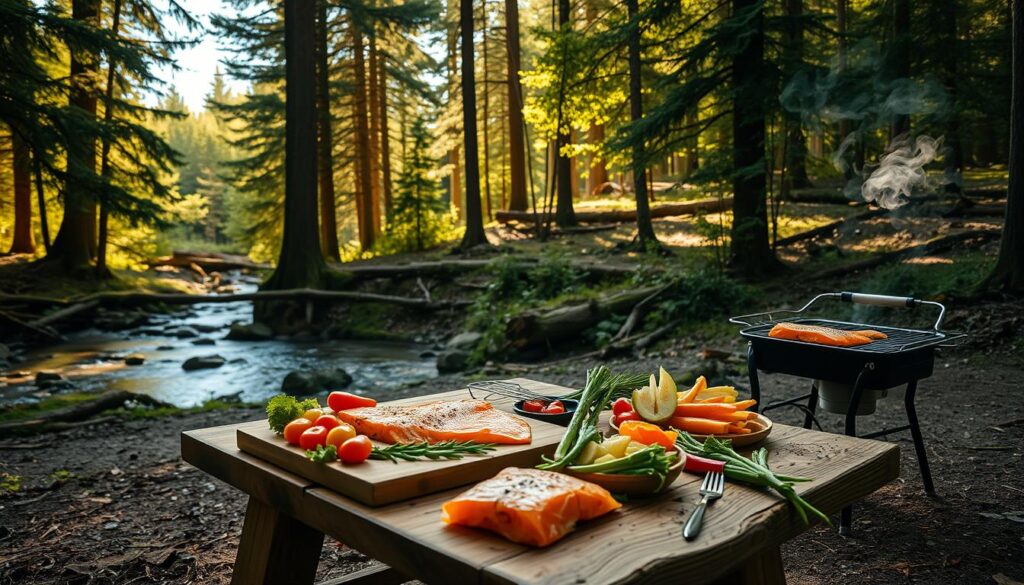
Conclusion
The wilderness salmon recipe in this article is a tasty, Asian-inspired dish perfect for outdoor adventures. It’s easy to make and tastes like a restaurant meal, even in the wilderness. You can cook it in a cast-iron skillet or on a cedar plank, making it a versatile choice for your outdoor meals.
When you go on your next outdoor trip, try different versions of this salmon recipe. Pair it with wild side dishes for a full outdoor dining experience. The secret to a great wilderness meal is in the details, from the marinade to how you cook it over a campfire.
Enjoying the wilderness salmon recipe lets you taste the fresh, wild flavors of Alaska while taking in the beauty of nature. This dish is not just a meal; it’s a celebration of sustainable fishing and connecting with nature. Use this recipe to make your next outdoor adventure even more special.
Have you tried our recipes and liked them? Leave us a review
There are no reviews yet. Be the first one to write one.
